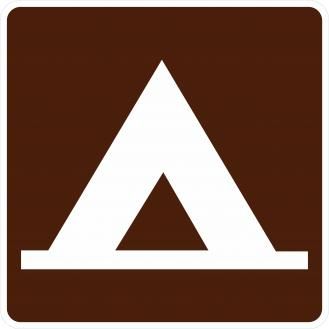
At a Glance
Adventure Type:Camping
Return Time: Sun 10:30am
Meet Time: Fri 5:00pm
Est Cost: 91.00 Per Night
Health form parts: ABB
Location: Champoeg State Heritage Area, Oregon
Note: https://stateparks.oregon.gov/index.cfm?do=park.profile&parkId=79
Champoeg State Heritage Area
Champoeg State Heritage Area features a rare combination of history, nature, and recreation. Situated south of Newberg along the scenic Willamette River, Champoeg's forests, fields, and wetlands recreate the landscape of a bygone era. This is the site where pioneers voted to form Oregon's first provisional government by a historical vote in 1843. A thriving town of 200 was established, only to be washed away during a great flood in 1861. This rich history earns the park’s placement on the National Register of Historic Places. A diversity of activities await. Enjoy walking or biking on the paved trails that pass historical landmarks and hug the river. Play the 18-hole disc golf course under the oak trees, relax at the multitude of scenic picnic areas, or fish or kayak from dock on the Willamette River. The ecologically rich landscape is home to more than 130 bird species, including seasonally nesting western bluebirds and acorn woodpeckers.
Guide to Safe Scouting
Adults complete the following:- SAFE Checklist
- Boy Scouts of America Scouter Code of Conduct
- Youth Protection and Adult Leadership
- Camping
- Chemical Fuels and Equipment
- Activity Planning and Risk Assessment
- Sports and Activities
- Transportation
- Incident Reporting
gear check
How are we going to prep?
gear check
What age appropriate modifications can be made?
None
Gear
- 10 Essentials
- Backpack
Pre-Adventure Skillsets
- Be Prepared
- Buddy System
- Camping
- Cooking & Tools
- First Aid
- Gps
- Leave No Trace
- Map & Compass
- Nature
Sample Agenda
Friday 5:00pm Meet at CCC 5:15pm Leave for Champoeg State Heritage Area 5:35pm Arrive at Champoeg State Heritage Area 5:45pm Setup camp & eat sack dinner 10:00 Lights out Saturday 7:00am Wake & breakfast 8:00am Finish breakfast & cleanup 8:30am Lashings and Knots 12:00pm Lunch 1:00pm Orienteering course 3:00pm TTFC 5:00pm Dinner 7:00pm Finish cleanup of Dinner 7:30pm Campfire Program - Patrol skits/songs - SM minute - etc 10:00 Lights out Sunday 7:00am Wake & breakfast 8:00am Finish breakfast & cleanup 8-9:00am breakdown camp & pack vehicles 9-9:30am Scouts' own 9:30-9:45am Closing Circle 10:00am Leave for CCC 10:30am Arrive at CCC for parent pickups
Rank Requirements
key: At Meeting / On Adventure
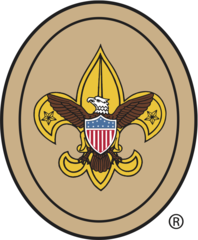
Tenderfoot
1c. Explain how you demonstrated the Outdoor Code and Leave No Trace on campouts or outings.
4a. Show first aid for the following: Simple cuts and scrapes, Blisters on the hand and foot, Minor (thermal/heat) burns or scalds (superficial, or first-degree), Bites or stings of insects and ticks, Venomous snakebite, Nosebleed, Frostbite and sunburn, Choking
5a. Explain the importance of the buddy system as it relates to your personal safety on outings and where you live. Use the buddy system while on a troop or patrol outing.
5b. Describe what to do if you become lost on a hike or campout.
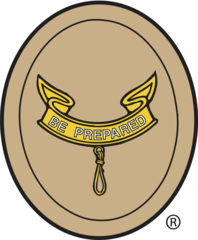
Second Class
1b. Recite the Leave No Trace Seven Principles from memory. Explain how you follow them on all outings.
3a. Demonstrate how a compass works and how to orient a map. Use a map to point out and tell the meaning of five map symbols.
4. Identify or show evidence of at least 10 kinds of wild animals (such as birds, mammals, reptiles, fish, or mollusks) found in your local area or camping location. You may show evidence by tracks, signs, or photographs you have taken.

First Class
1b. Explain the potential impacts of camping, both on the environment and on other outdoor users. Explain why the Outdoor Code and Leave No Trace Seven Principles are important for protecting the outdoors.
4b. Demonstrate how to use a handheld GPS unit, GPS app on a smartphone, or other electronic navigation system while on a campout or hike. Use GPS to find your current location, a destination of your choice, and the route you will take to get there. Follow that route to arrive at your destination.
5a. Identify or show evidence of at least 10 kinds of native plants found in your local area or campsite location. You may show evidence by identifying fallen leaves or fallen fruit that you find in the field, or as part of a collection you have made, or by photographs you have taken.
5b. Identify two ways to obtain a weather forecast for an upcoming activity. Explain why weather forecasts are important when planning for an event.
5c. Describe at least three natural indicators of impending hazardous weather, the potential dangerous events that might result from such weather conditions, and the appropriate actions to take.
5d. Describe extreme weather conditions you might encounter in the outdoors in your local geographic area. Discuss how you would determine ahead of time the potential risk of these types of weather dangers, alternative planning considerations to avoid such risks, and how you would prepare for and respond to those weather conditions.
Awards
key: At Meeting / On Adventure
Merit Badges
key: At Meeting / On Adventure
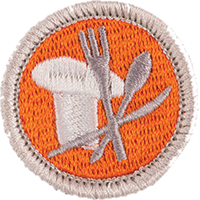
Cooking
1a. Explain to your counselor the most likely hazards you may encounter while participating in cooking activities and what you should do to anticipate, help prevent, mitigate, and respond to these hazards
1b. Show that you know first aid for and how to prevent injuries or illnesses that could occur while preparing meals and eating, including burns and scalds, cuts, choking, and allergic reactions.
1c. Describe how meat, fish, chicken, eggs, dairy products, and fresh vegetables should be stored, transported, and properly prepared for cooking. Explain how to prevent cross-contamination.
1d. Discuss with your counselor food allergies, food intolerance, and food-related illnesses and diseases. Explain why someone who handles or prepares food needs to be aware of these concerns.
1e. Discuss with your counselor why reading food labels is important. Explain how to identify common allergens such as peanuts, tree nuts, milk, eggs, wheat, soy, and shellfish.
2a. Fruits
2b. Vegetables
2c. Grains
2d. Proteins
2e. Dairy
2f. Dairy
2g. Explain why you should limit your intake of oils and sugars.
3b. Discuss the benefits of using a camp stove on an outing vs. a charcoal or wood fire.
5a. Using the MyPlate food guide or the current USDA nutrition model, plan a menu that includes four meals, one snack, and one dessert for your patrol (or a similar size group of up to eight youth, including you) on a camping trip. Your menus should include enough food for each person, keeping in mind any special needs (such as food allergies) and how you keep your foods safe and free from cross-contamination. These four meals must include two breakfasts, one lunch, and one dinner. Additionally, you must plan one snack and one dessert. List the equipment and utensils needed to prepare and serve these meals.
5b. Find or create recipes for the four meals, the snack, and the dessert you have planned. Adjust menu items in the recipes for the number to be served. Create a shopping list and budget to determine the per-person cost.
5e. In the outdoors, prepare a dessert OR a snack and serve it to your patrol or a group of youth.**
5f. After each meal, have those you served evaluate the meal on presentation and taste, and then evaluate your own meal. Discuss what you learned with your counselor, including any adjustments that could have improved or enhanced your meals. Tell how planning and preparation help ensure successful outdoor cooking.
5g. Lead the clean-up of equipment, utensils, and the cooking site thoroughly after each meal. Properly store or dispose unused ingredients, leftover food, dishwater and garbage.
5h. Discuss how you followed the Outdoor Code and no-trace principles when preparing your meals.
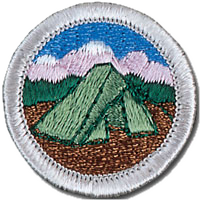
Camping
1a. Explain to your counselor the most likely hazards you may encounter while participating in camping activities and what you should do to anticipate, help prevent, mitigate, and respond to these hazards
1b. Discuss with your counselor why it is important to be aware of weather conditions before and during your camping activities. Tell how you can prepare should the weather turn bad during your campouts.
1c. Show that you know first aid for and how to prevent injuries or illnesses that could occur while camping, including hypothermia, frostbite, heat reactions, dehydration, altitude sickness, insect stings, tick bites, snakebite, blisters, and hyperventilation.
2. Learn the Leave No Trace principles and the Outdoor Code and explain what they mean. Write a personal and group plan for implementing these principles on your next outing..:
3a. A compass
3b. A GPS receiver 2
3c. A smartphone with a GPS app 2
4a. Make a duty roster showing how your patrol is organized for an actual overnight campout. List assignments for each member.
4b. Help a Scout patrol or a Webelos Scout unit in your area prepare for an actual campout, including creating the duty roster, menu planning, equipment needs, general planning, and setting up camp.
5a. Prepare a list of clothing you would need for overnight campouts in both warm and cold weather. Explain the term "layering."
5b. Discuss footwear for different kinds of weather and how the right footwear is important for protecting your feet.
5c. Explain the proper care and storage of camping equipment (clothing, footwear, bedding).
5d. List the outdoor essentials necessary for any campout, and explain why each item is needed.
5e. Present yourself to your Scoutmaster with your pack for inspection. Be correctly clothed and equipped for an overnight campout.
6a. Describe the features of four types of tents, when and where they could be used, and how to care for tents. Working with another Scout, pitch a tent.
6b. Discuss the importance of camp sanitation and tell why water treatment is essential. Then demonstrate two ways to treat water.
6c. Describe the factors to be considered in deciding where to pitch your tent.
6d. Tell the difference between internal- and external-frame packs. Discuss the advantages and disadvantages of each.
6e. Discuss the types of sleeping bags and what kind would be suitable for different conditions. Explain the proper care of your sleeping bag and how to keep it dry. Make a comfortable ground bed.
7a. Make a checklist of personal and patrol gear that will be needed.
7b. Pack your own gear and your share of the patrol equipment and food for proper carrying. Show that your pack is right for quickly getting what is needed first, and that it has been assembled properly for comfort, weight, balance, size, and neatness.
8a. Using a propane or butane/propane stove
8b. Using a liquid fuel stove
8c. Proper storage of extra fuel
8d. Proper storage of extra fuel
8e. Discuss the advantages and disadvantages of different types of lightweight cooking stoves.
8f. Prepare a camp menu. Explain how the menu would differ from a menu for a backpacking or float trip. Give recipes and make a food list for your patrol. Plan two breakfasts, three lunches, and two suppers. Discuss how to protect your food against bad weather, animals, and contamination.
8g. While camping in the outdoors, cook at least one breakfast, one lunch, and one dinner for your patrol from the meals you have planned for requirement 8c. At least one of those meals must be a trail meal requiring the use of a lightweight stove. The requirements for Cooking merit badge include the following note immediately before requirements 4, 5, & 6. Note: The meals prepared for Cooking merit badge requirements 4, 5, and 6 will count only toward fulfilling those requirements and will not count toward rank advancement or other merit badges. Meals prepared for rank advancement or other merit badges may not count toward the Cooking merit badge. You must not repeat any menus for meals actually prepared or cooked in requirements 4, 5, and 6. Therefore, The meals prepared for Camping merit badge requirement 8d may not count toward Cooking merit badge, requirements 4, 5, or 6. Meals prepared for Cooking merit badge requirements 4, 5, and 6 may not count toward Camping merit badge requirement 8d.
Flier
www.Sherwood116.com
Troop 116
Camping @ Champoeg State Heritage AreaChampoeg State Heritage Area features a rare combination of history, nature, and recreation. Situated south of Newberg along the scenic Willamette River, Champoeg's forests, fields, and wetlands recreate the landscape of a bygone era. This is the site where pioneers voted to form Oregon's first provisional government by a historical vote in 1843. A thriving town of 200 was established, only to be washed away during a great flood in 1861. This rich history earns the park’s placement on the National Register of Historic Places. A diversity of activities await. Enjoy walking or biking on the paved trails that pass historical landmarks and hug the river. Play the 18-hole disc golf course under the oak trees, relax at the multitude of scenic picnic areas, or fish or kayak from dock on the Willamette River. The ecologically rich landscape is home to more than 130 bird species, including seasonally nesting western bluebirds and acorn woodpeckers.

Camping!
Champoeg State Heritage Area
St Paul, Oregon
St Paul, Oregon

Fri 5:00pm - Sun 10:30am

meet at Cedar Creek Church on < date > @ Fri 5:00pm

Whole Troop!
We’ll meet at Cedar Creek Church @ Fri 5:00pm and carpool to Champoeg State Heritage Area in St Paul, Oregon.
Gear
- 10 Essentials
- Backpack
Skills
- Be prepared
- Buddy System
- Camping
- Cooking & Tools
- First aid
- GPS
- Leave no trace
- Map & Compass
- Nature

Make sure to register on troopmaster,
look for the link in your email!!!
look for the link in your email!!!



Troop 116
T-Program Planningfor Campout
Prior to T-5, the PLC should have determined (and dates below):
Outing Event:________________________
Event Date:_______________
Location: ___________________________
Scout in charge: ______________________
QR Code/URL for drive
Itinerary:
Special activities and equipment needed for the outing:
T-5 Date:_______________
- Patrol Leaders hand out event flyers and permission slips and get a straw count.
- Patrol Leaders assign Grubmasters and Assistant Grubmasters (based on advancement
- needs).
- Patrols plan their camp activities.
T-4 Date:_______________
- (PLC assigns SPL and PL’s in charge of outing, SM/ASM’s identify the tour leader.)
- Scouts return permission slips and trip fees to their Patrol Leaders.
- Grubmasters presents menus, make necessary changes, and get SPL/ASM approvals.
- Patrols discuss activity materials and assign Scouts responsible for acquiring materials.
- Patrols plan campfire skits and songs.
T-3 Date:_______________
- Grubmasters assign duty roster responsibilities within their patrols.
- Patrols assign/select tent partners.
- Patrols discuss gear needs and who brings what. Patrol Quartermaster makes gear list
T-2 Date:_______________
- Patrols finalize activity and campfire plans – get SPL/ASM approval.
- Patrols finalize gear and equipment needs, make arrangements with Troop Quartermaster.
T-1 Date:_______________
- Patrols check out tents and other camping gear.
- Grubmasters check out necessary cooking gear.
- Grubmasters receive food money from the troop treasurer.
- Patrols discuss free-time activities.
- Troop Gear Check
T+1 Date:_______________
- Patrols and Grubmasters check in gear and inventory sheets.
- Patrols complete event evaluation.
Week 1

Month's Theme: Camping
Topic: ________________
Date: _____________
Topic: ________________
Date: _____________

Activity
Description
Run By
Time
Pre-opening Activity
Opening Ceremony
- - Flag presentation
- - Oath and Law
- - Uniform inspection
Group Instruction
- - Leave No Trace
- - Gps
Skills Instruction
Scout - Tenderfoot
Scout - Tenderfoot
-

1c. Explain how you demonstrated the Outdoor Code and Leave No Trace on campouts or outings. [Leave No Trace]
2nd - 1st
-

1b. Recite the Leave No Trace Seven Principles from memory. Explain how you follow them on all outings. [Leave No Trace]
-

1b. Explain the potential impacts of camping, both on the environment and on other outdoor users. Explain why the Outdoor Code and Leave No Trace Seven Principles are important for protecting the outdoors. [Leave No Trace]
Merit Badge
-

5h. Discuss how you followed the Outdoor Code and no-trace principles when preparing your meals. [Leave No Trace]
-

2. Learn the Leave No Trace principles and the Outdoor Code and explain what they mean. Write a personal and group plan for implementing these principles on your next outing..: [Leave No Trace]
-
3b. A GPS receiver 2 [Gps]
-
3c. A smartphone with a GPS app 2 [Gps]
Patrol Breakouts
- - T-Minus activities (Duty roster/Menu/etc)
- - Patrol outing planning
- - Advancement check-in (see how advancement is going and what is needed -> report to SPL)
- - (Seasonal planning) Summer camp activities, APC Ideas
Game
Closing
- - Closing Flags
- - Announcements
- - SM’s minute
Total 90 minutes of meeting
After the meeting
Leadership team reviews plans for the next meeting and for the main event.
Week 2

Month's Theme: Camping
Topic: ________________
Date: _____________
Topic: ________________
Date: _____________

Activity
Description
Run By
Time
Pre-opening Activity
Opening Ceremony
- - Flag presentation
- - Oath and Law
- - Uniform inspection
Group Instruction
- - First Aid
- - Nature
Skills Instruction
Scout - Tenderfoot
Scout - Tenderfoot
-

4a. Show first aid for the following: Simple cuts and scrapes, Blisters on the hand and foot, Minor (thermal/heat) burns or scalds (superficial, or first-degree), Bites or stings of insects and ticks, Venomous snakebite, Nosebleed, Frostbite and sunburn, Choking [First Aid]
2nd - 1st
-

5b. Identify two ways to obtain a weather forecast for an upcoming activity. Explain why weather forecasts are important when planning for an event. [Nature]
-
5c. Describe at least three natural indicators of impending hazardous weather, the potential dangerous events that might result from such weather conditions, and the appropriate actions to take. [Nature]
-
5d. Describe extreme weather conditions you might encounter in the outdoors in your local geographic area. Discuss how you would determine ahead of time the potential risk of these types of weather dangers, alternative planning considerations to avoid such risks, and how you would prepare for and respond to those weather conditions. [Nature]
Merit Badge
-

1b. Show that you know first aid for and how to prevent injuries or illnesses that could occur while preparing meals and eating, including burns and scalds, cuts, choking, and allergic reactions. [First Aid]
-

1b. Discuss with your counselor why it is important to be aware of weather conditions before and during your camping activities. Tell how you can prepare should the weather turn bad during your campouts. [Nature]
-
1c. Show that you know first aid for and how to prevent injuries or illnesses that could occur while camping, including hypothermia, frostbite, heat reactions, dehydration, altitude sickness, insect stings, tick bites, snakebite, blisters, a... [First Aid]
Patrol Breakouts
- - T-Minus activities (Duty roster/Menu/etc)
- - Patrol outing planning
- - Advancement check-in (see how advancement is going and what is needed -> report to SPL)
- - (Seasonal planning) Summer camp activities, APC Ideas
Game
Closing
- - Closing Flags
- - Announcements
- - SM’s minute
Total 90 minutes of meeting
After the meeting
Leadership team reviews plans for the next meeting and for the main event.
Week 3

Month's Theme: Camping
Topic: ________________
Date: _____________
Topic: ________________
Date: _____________

Activity
Description
Run By
Time
Pre-opening Activity
Opening Ceremony
- - Flag presentation
- - Oath and Law
- - Uniform inspection
Group Instruction
- - Buddy System
- - Map & Compass
- - Cooking & Tools
Skills Instruction
Scout - Tenderfoot
Scout - Tenderfoot
-

5a. Explain the importance of the buddy system as it relates to your personal safety on outings and where you live. Use the buddy system while on a troop or patrol outing. [Buddy System]
2nd - 1st
-

3a. Demonstrate how a compass works and how to orient a map. Use a map to point out and tell the meaning of five map symbols. [Map & Compass]
Merit Badge
-

1a. Explain to your counselor the most likely hazards you may encounter while participating in cooking activities and what you should do to anticipate, help prevent, mitigate, and respond to these hazards [Cooking & Tools]
-
1c. Describe how meat, fish, chicken, eggs, dairy products, and fresh vegetables should be stored, transported, and properly prepared for cooking. Explain how to prevent cross-contamination. [Cooking & Tools]
-
1d. Discuss with your counselor food allergies, food intolerance, and food-related illnesses and diseases. Explain why someone who handles or prepares food needs to be aware of these concerns. [Cooking & Tools]
-
1e. Discuss with your counselor why reading food labels is important. Explain how to identify common allergens such as peanuts, tree nuts, milk, eggs, wheat, soy, and shellfish. [Cooking & Tools]
-
2a. Fruits [Cooking & Tools]
-
2b. Vegetables [Cooking & Tools]
-
2c. Grains [Cooking & Tools]
-
2d. Proteins [Cooking & Tools]
-
2e. Dairy [Cooking & Tools]
-
2f. Dairy [Cooking & Tools]
-
2g. Explain why you should limit your intake of oils and sugars. [Cooking & Tools]
-
3b. Discuss the benefits of using a camp stove on an outing vs. a charcoal or wood fire. [Cooking & Tools]
-
5a. Using the MyPlate food guide or the current USDA nutrition model, plan a menu that includes four meals, one snack, and one dessert for your patrol (or a similar size group of up to eight youth, including you) on a camping trip. Your menu... [Cooking & Tools]
-
5b. Find or create recipes for the four meals, the snack, and the dessert you have planned. Adjust menu items in the recipes for the number to be served. Create a shopping list and budget to determine the per-person cost. [Cooking & Tools]
-

3a. A compass [Map & Compass]
-
8a. Using a propane or butane/propane stove [Cooking & Tools]
-
8b. Using a liquid fuel stove [Cooking & Tools]
-
8c. Proper storage of extra fuel [Cooking & Tools]
-
8d. Proper storage of extra fuel [Cooking & Tools]
-
8e. Discuss the advantages and disadvantages of different types of lightweight cooking stoves. [Cooking & Tools]
-
8f. Prepare a camp menu. Explain how the menu would differ from a menu for a backpacking or float trip. Give recipes and make a food list for your patrol. Plan two breakfasts, three lunches, and two suppers. Discuss how to protect your food ... [Cooking & Tools]
Patrol Breakouts
- - T-Minus activities (Duty roster/Menu/etc)
- - Patrol outing planning
- - Advancement check-in (see how advancement is going and what is needed -> report to SPL)
- - (Seasonal planning) Summer camp activities, APC Ideas
Game
Closing
- - Closing Flags
- - Announcements
- - SM’s minute
Total 90 minutes of meeting
After the meeting
Leadership team reviews plans for the next meeting and for the main event.
Week 4

Month's Theme: Camping
Topic: ________________
Date: _____________
Topic: ________________
Date: _____________

Activity
Description
Run By
Time
Pre-opening Activity
Opening Ceremony
- - Flag presentation
- - Oath and Law
- - Uniform inspection
Group Instruction
- - Be Prepared
- - Camping
Skills Instruction
Scout - Tenderfoot
Scout - Tenderfoot
-

5b. Describe what to do if you become lost on a hike or campout. [Be Prepared]
2nd - 1st
Merit Badge
-

1a. Explain to your counselor the most likely hazards you may encounter while participating in camping activities and what you should do to anticipate, help prevent, mitigate, and respond to these hazards [Camping]
-
4a. Make a duty roster showing how your patrol is organized for an actual overnight campout. List assignments for each member. [Camping]
-
4b. Help a Scout patrol or a Webelos Scout unit in your area prepare for an actual campout, including creating the duty roster, menu planning, equipment needs, general planning, and setting up camp. [Camping]
-
5a. Prepare a list of clothing you would need for overnight campouts in both warm and cold weather. Explain the term "layering." [Camping]
-
5b. Discuss footwear for different kinds of weather and how the right footwear is important for protecting your feet. [Camping]
-
5c. Explain the proper care and storage of camping equipment (clothing, footwear, bedding). [Camping]
-
5d. List the outdoor essentials necessary for any campout, and explain why each item is needed. [Camping]
-
5e. Present yourself to your Scoutmaster with your pack for inspection. Be correctly clothed and equipped for an overnight campout. [Camping]
-
6a. Describe the features of four types of tents, when and where they could be used, and how to care for tents. Working with another Scout, pitch a tent. [Camping]
-
6b. Discuss the importance of camp sanitation and tell why water treatment is essential. Then demonstrate two ways to treat water. [Camping]
-
6c. Describe the factors to be considered in deciding where to pitch your tent. [Camping]
-
6d. Tell the difference between internal- and external-frame packs. Discuss the advantages and disadvantages of each. [Camping]
-
6e. Discuss the types of sleeping bags and what kind would be suitable for different conditions. Explain the proper care of your sleeping bag and how to keep it dry. Make a comfortable ground bed. [Camping]
-
7a. Make a checklist of personal and patrol gear that will be needed. [Camping]
-
7b. Pack your own gear and your share of the patrol equipment and food for proper carrying. Show that your pack is right for quickly getting what is needed first, and that it has been assembled properly for comfort, weight, balance, size, an... [Camping]
Patrol Breakouts
- - T-Minus activities (Duty roster/Menu/etc)
- - Patrol outing planning
- - Advancement check-in (see how advancement is going and what is needed -> report to SPL)
- - (Seasonal planning) Summer camp activities, APC Ideas
Game
Closing
- - Closing Flags
- - Announcements
- - SM’s minute
Total 90 minutes of meeting
After the meeting
Leadership team reviews plans for the next meeting and for the main event.